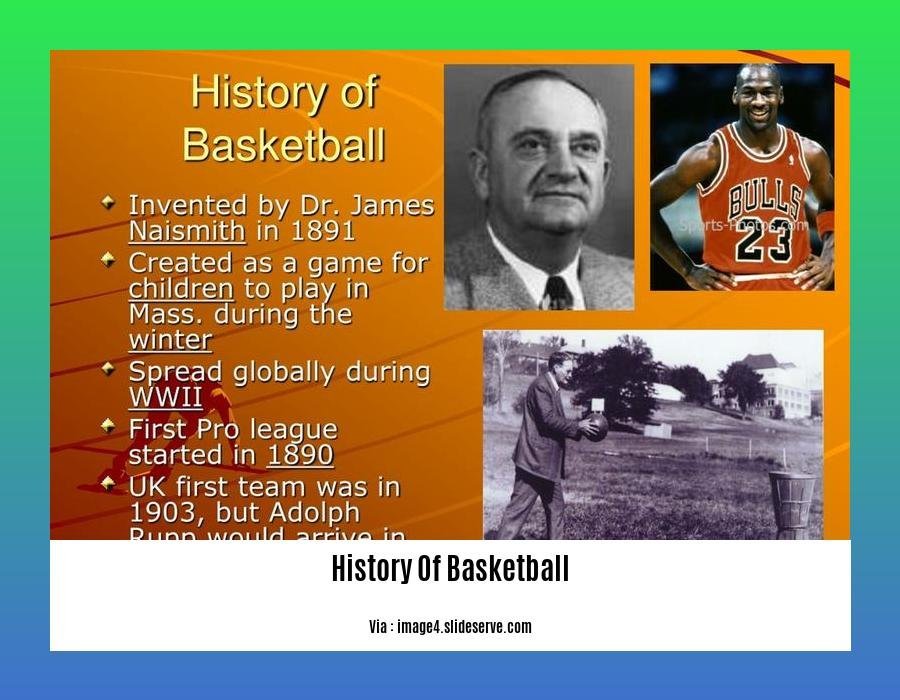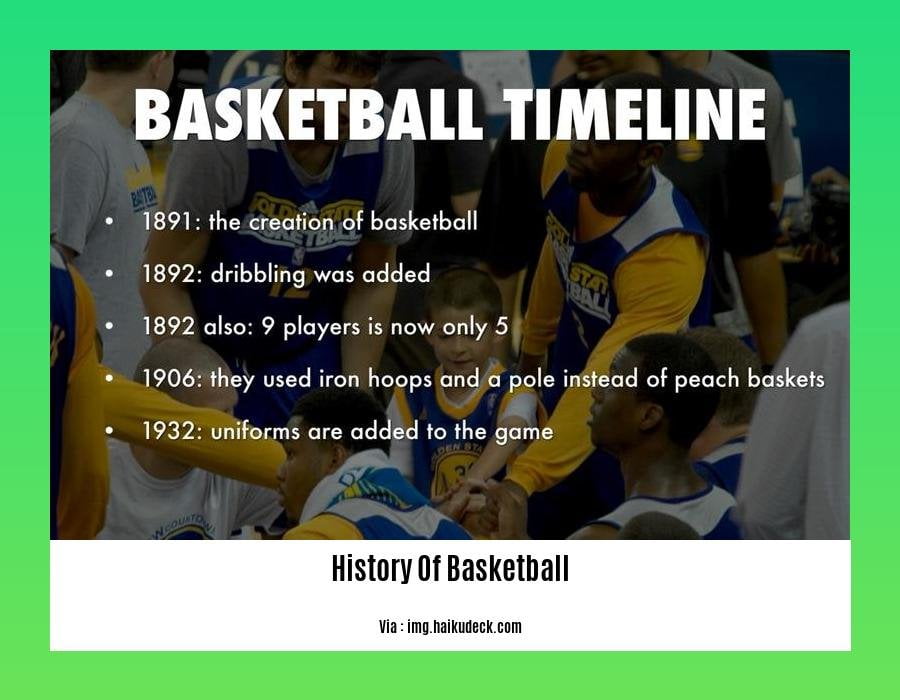Embark on [A Journey Through the Enthralling History of Basketball] as we delve into the captivating origins of this beloved sport. From the ingenious invention of the game by James Naismith to the evolution of the original rules, witness the remarkable journey that propelled basketball onto the world stage, captivating hearts and igniting a global passion for the game.
Key Takeaways:
- Basketball was invented by James Naismith in 1891 as an indoor winter activity for his students.
- Peach baskets were initially used as goals, and dribbling and backboards were not allowed in the original rules.
- The first public basketball game was played between instructors and students in 1892.
- The first college basketball game took place in 1896.
- Basketball became an Olympic sport in 1936, with the USA winning gold.
History of Basketball

Our beloved sport of basketball is a testament to human ingenuity and the power of physical activity. Its origins can be traced back to 1891 in Springfield, Massachusetts. That’s when James Naismith, a Canadian physical education instructor, searched for a solution to keep his students active during the dreary winter months. With some creativity, he came up with a game using peach baskets as goals and a soccer ball as the projectile.
The game caught on like wildfire, and soon basketball was being played in YMCAs and colleges across the country. The first public game took place in 1892, and just four years later, the first college basketball game was contested between Iowa and Chicago.
Basketball’s popularity soared, and by 1936, it had become an official Olympic sport. The United States reigned supreme, capturing the gold medal in Berlin.
Over the decades, the history of basketball has been shaped by legendary players, iconic teams, and rule changes. Wilt Chamberlain’s 100-point game, Michael Jordan’s gravity-defying dunks, and the Boston Celtics’ record-setting championship run are just a few examples of the moments that have etched themselves into the annals of the sport.
Today, basketball continues to captivate fans around the globe, with professional leagues and tournaments drawing millions of viewers. Its legacy as a symbol of athleticism, teamwork, and entertainment remains as strong as ever.
Once James Naismith’s invention gained recognition, it led to the formation of the NBA in 1946. Basketball’s rules continued to evolve. The game is now played in more than 200 countries, signaling its global spread.
The original rules.

Basketball’s genesis can be traced back to 1891, when James Naismith, a Canadian physical education instructor, devised a set of 13 rules to govern a new indoor sport he had invented. These original rules laid the groundwork for the game we know and love today.
Key Takeaways:
- In 1891, James Naismith invented basketball.
- 13 rules were established by Naismith for the game.
- The original rules prohibited dribbling and running with the ball.
- Physical contact was not allowed.
- The free-throw line was set at 20 feet.
Sources:
- Basketball.org
- NCAA
How Basketball Took the World by Storm
Basketball’s Allure: A Global Phenomenon
Basketball’s captivating nature has captivated hearts worldwide, transforming it into a beloved sport. Its appeal transcends geographical boundaries, uniting people from diverse backgrounds in a shared passion. Let’s delve into the key factors that propelled basketball’s global takeover:
H3: Humble Beginnings to International Stardom
From its humble origins in Springfield, Massachusetts, basketball’s trajectory has been nothing short of remarkable. The game, initially conceived as a winter activity for students, rapidly gained popularity within the U.S. Following World War II, basketball soared to new heights, spreading across continents and captivating global audiences.
H3: Fast-Paced Action and Elite Athletes
Basketball’s fast-paced and dynamic nature adds to its allure. The game’s constant flow, combined with the incredible skills displayed by its athletes, creates an electrifying spectacle that keeps fans on the edge of their seats. Players like Michael Jordan, LeBron James, and Kobe Bryant have showcased extraordinary abilities, inspiring generations and solidifying the sport’s global appeal.
H3: Cultural Impact and Social Significance
Basketball has transcended the realm of sports, becoming deeply intertwined with popular culture. Its influence is evident in music, fashion, and even language. The sport has also fostered a sense of community, providing a shared experience for people from all walks of life.
Key Takeaways:
- Global Popularity: Basketball has become a global phenomenon, captivating audiences worldwide.
- Exciting Gameplay: The fast-paced, dynamic nature of the game adds to its allure.
- Exceptional Athletes: Elite players like Michael Jordan have showcased extraordinary skills, inspiring generations.
- Cultural Impact: Basketball has become a cultural phenomenon, influencing music, fashion, and popular culture.
- Social Significance: The sport fosters a sense of community and provides a shared experience for people from diverse backgrounds.
Sources:
- The History of Basketball | Encyclopedia Britannica
- How Basketball Took The World By Storm – History Of Basketball
FAQ
Q1: Who invented basketball and when?
A1: James Naismith, a Canadian physical education instructor, invented basketball in 1891.
Q2: What were the original rules of basketball?
A2: The original rules of basketball prohibited dribbling and backboards and featured 13 points.
Q3: When did basketball become an Olympic sport?
A3: Basketball became an Olympic sport in 1936 in Berlin.
Q4: How did basketball gain popularity worldwide?
A4: Basketball gained popularity in the US and internationally after World War II.
Q5: What key innovations helped basketball evolve into the fast-paced game we know today?
A5: The introduction of the dribble and the backboard were key innovations that helped basketball evolve into a fast-paced and exciting sport.















